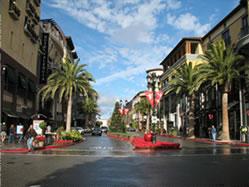Mixed-Use Trip Generation Model

Research consistently shows that neighborhoods that mix land uses, make walking safe and convenient, and are near other development allow residents and workers to drive significantly less if they choose. In fact, in the most centrally located, well-designed neighborhoods, residents drive as little as half as much as residents of outlying areas.1
Along with these benefits, mixed-use development can improve communities in other important ways, including supporting affordable housing by lowering transportation costs.2 Studies have shown that mixed-use development, especially in concert with other smart growth strategies, provides significantly higher returns to local governments through property and sales taxes3 while requiring lower per unit infrastructure and public-service costs.4
The typical development planning and approval process treats mixed-use developments as though the uses were separated and accessible only by car, leaving mixed-use developments at a disadvantage compared to conventional, single-use developments. Recognizing the lower traffic impacts of mixed-use development in central, well-connected neighborhoods in the planning and approvals process would help communities reduce traffic and realize other benefits.

The technical methods to estimate how much traffic a new development will create, known as trip generation analysis, have been standardized by the Institute of Transportation Engineers (ITE) and are used by traffic engineers across the country.
However, these methods are generally based on data collected from single-use, automobile-dependent, suburban sites. They do allow for some internal capture (trips that might be entirely within larger, mixed-use developments), but in general the methods do not adequately account for the effects of compact development, mix of uses, site design, walkability, transit, and regional accessibility – key elements of smart growth strategies and of a sustainable community.
To help give communities better tools to analyze new development, EPA, in cooperation with ITE, worked with leading researchers and practitioners to develop new data and methods to estimate the trip-generation impacts of mixed-use developments. EPA analyzed six metropolitan regions, merging data from household travel surveys, GIS databases, and other sources to create consistent land use and travel measures.
The resulting linked models estimate internal capture of trips within mixed-use developments as well as walking and transit use for trips starting or ending in mixed-use developments. The models have been validated against actual traffic counts at mixed-use developments across the country. The method is currently used in several regions in California, Washington, and New Mexico, and the Virginia Department of Transportation adopted it as a statewide standard for determining the traffic impacts of urban developments.
The EPA team put the models into a spreadsheet tool that makes it easy for local government staff, consultants, and developers to estimate trips generated by a new mixed-use development. The spreadsheet estimates vehicle trips in the peak periods and for an entire day. The method also predicts trips by walking and transit and estimates the daily vehicle miles of travel associated with the development.
The tool requires information about the development site and its surrounding area, including geographic, demographic, and land use characteristics. It includes default national parameters for trip generation but allows the use of local values if available. An associated report describes the analytic basis for the method and the data used to calibrate and validate it. It is available upon request.
The following resources give more information on development and testing of the method and San Diego's use of the tool:
- Traffic Generated by Mixed-Use Developments – A Six-Region Study Using Consistent Built Environmental Measures, Exit Ewing et al., ASCE Journal of Urban Planning and Development, 2010. This peer-reviewed article describes the analytic basis for the models, database development, and reports on validation tests. (Fee or subscription required.)
- Traffic Generated by MXD: New Prediction Methods Ahead (PDF) (2 pp, 238K, About PDF), Exit Reid Ewing, Planning: The Magazine of the American Planning Association, April 2011. Aimed at practicing planners, this article by one of the method’s developers describes the models in a relatively non-technical tone.
- Mixed-Use Development (MXD) Trip Generation, Exit Fehr & Peers. This website, by the firm that led development of the tool for EPA, describes the tool and reports on the statistical validation of the models.
- Smart Growth Trip Generation and Parking Study, Exit San Diego Association of Governments (SANDAG), 2010. SANDAG approved the method for use regionwide following comparison to local sites and review by local staff. This web page provides details on its review and implementation.
The following resources describe the standard trip generation methods and other recent efforts to better understand the impacts of mixed-use developments and related smart growth strategies:
- Trip Generation Handbook (2nd ed.): An ITE Recommended Practice, Exit 2004. This ITE Recommended Practice represents the industry standard for estimating trip generation for site impact studies and includes a summary of previous work on mixed-use developments.
- Trip Generation (8th ed.), Exit Institute of Transportation Engineers, 2008. This ITE Informational Report documents the underlying land use categories and datasets used for estimating trip generation.
- Trip Generation: Other Resources, Exit Institute of Transportation Engineers. Compilation of links to ongoing and completed studies of trip generation at mixed-use and other developments.
- Enhancing Internal Trip Capture Estimation for Mixed-Use Developments, Exit National Cooperative Highway Research Program Report 684, 2011. This method, similar in scope to the EPA method described above, estimates peak-period internal capture rates for mixed-use developments for use in standard ITE trip generation applications.
- Effects of TOD on Housing, Parking, and Travel, Exit Transit Cooperative Research Program Report 128, 2008. This report gives insight into the characteristics of residents of transit-oriented development, including their trip generation rates.
1. Litman, Todd, and Rowan Steele. Land Use Impacts on Transport: How Land Use Factors Affect Travel Behavior (PDF) (73 pp, 667 K, About PDF). Exit 2011.
2. Penny Wise, Pound Fuelish: New Measures of Housing + Transportation Affordability. Exit Center for Neighborhood Technology. 2010.
3. Why Transit-Oriented Development and Why Now? Exit Reconnecting America and the Center for Transit-Oriented Development. 2007.
4. Burchell, Robert, et al. Sprawl Costs: Economic Impacts of Unchecked Development. Island Press. 2005.
